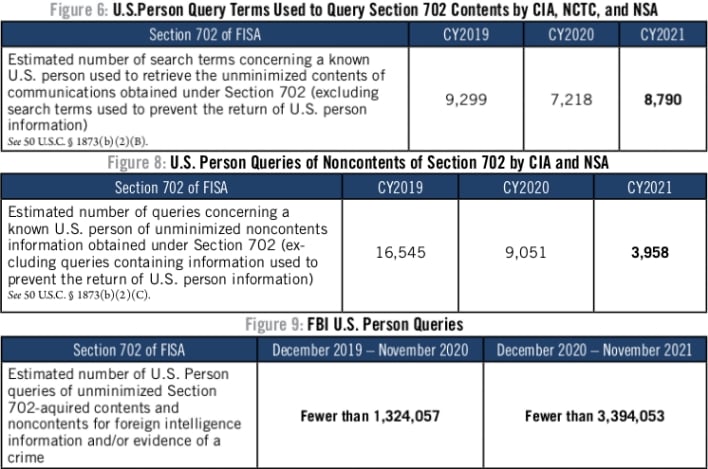US National Intelligence Transparency Report Details Alarming Rise In Warrantless Data Searches

Earlier this week, we covered leaked details regarding a government contractor that demonstrated its ability to track billions of phones all over the world by spying on CIA and NSA agents’ activity. Government contractors are able to provide surveillance services by purchasing user data from third parties. However, US government agencies have fairly extensive surveillance capabilities of their own. Section 702 of the Foreign Intelligence Surveillance Act (FISA) authorizes collection and storage of the phone calls, text messages, emails, and other electronic communications of both American citizens and foreigners. US intelligence agencies are then able to search the resulting database without requiring warrants.
Since 2014, the Office of the Director of National Intelligence (ODNI) has published an Annual Statistical Transparency Report (ASTR) detailing the Intelligence Community’s (IC) use of National Security Surveillance Authorities. Unfortunately, these reports provide only a hazy view into the activity of US intelligence agencies. The various intelligence agencies don’t have a shared standard for recording and reporting their use of surveillance powers, and the standards they use make it difficult to tell what the numbers actually mean.
Since 2014, the Office of the Director of National Intelligence (ODNI) has published an Annual Statistical Transparency Report (ASTR) detailing the Intelligence Community’s (IC) use of National Security Surveillance Authorities. Unfortunately, these reports provide only a hazy view into the activity of US intelligence agencies. The various intelligence agencies don’t have a shared standard for recording and reporting their use of surveillance powers, and the standards they use make it difficult to tell what the numbers actually mean.

Nonetheless, the newly released report for 2021 includes a significant addition. Previous years’ reports have been notably missing statistics regarding the number of times the FBI has searched the Section 702 database for information on US persons. However, the most recent report includes the number of such queries for both 2020 and 2021. According to this report, the FBI conducted “fewer than” roughly 3.4 million warrantless searches of Americans’ electronic communication data in 2021. This number is up from 1.3 million in 2020.
The FBI numbers are drastically higher than those of other intelligence agencies, which is largely due to the fact that the FBI has a special authorization to search the Section 702 database for domestic surveillance. Other intelligence agencies are limited in scope to foreign intelligence, so their searches for information involving US persons are carried out while in the course of gathering foreign intelligence. The FBI, on the other hand, performs both foreign intelligence gathering and domestic law enforcement, so the FBI is able to surveil Americans’ electronic communications more directly.
The figures above also make the distinction between “contents” and “noncontents,” with noncontents being metadata. Metadata, in this case, is data about people’s electronic communications, such as timestamps, phone numbers, email addresses, and IP addresses, but not the content of the communications. The FBI, NSA, and CIA have access to both contents and noncontents, while the National Counterterrorism Center (NCTC) is restricted to just contents.
As stated earlier, the standards used to count the intelligence agencies’ uses of surveillance powers make it difficult to form an accurate picture of how the powers are used. The report provides the following disclaimer: “The number of FBI queries does not reflect the number of U.S. persons associated with these queries. For example, a single U.S. person might be associated with 10 unique query terms including name, social security number, passport number, phone number, multiple email addresses, etc. These 10 identifiers could be run 10 different times throughout the reporting period, resulting in 100 queries associated with a single individual. Query terms may also be associated with a U.S. company rather than a specific U.S. person.” The report is riddled with additional caveats, such as the fact that the FBI performs bulk queries with multiple search terms where each term is counted as a separate query.
The report also provides an official explanation for the significant rise in FBI searches in 2021 over the prior year. “In the first half of the year, there were a number of large batch queries related to attempts to compromise U.S. critical infrastructure by foreign cyber actors. These queries, which included approximately 1.9 million query terms related to potential victims—including U.S. persons—accounted for the vast majority of the increase in U.S. person queries conducted by FBI over the prior year.” However, even if we subtract 1.9 million, we’re still left with 1.5 million FBI searches of Americans’ electronic communications in 2021, which is an increase over 2020.
The FBI numbers are drastically higher than those of other intelligence agencies, which is largely due to the fact that the FBI has a special authorization to search the Section 702 database for domestic surveillance. Other intelligence agencies are limited in scope to foreign intelligence, so their searches for information involving US persons are carried out while in the course of gathering foreign intelligence. The FBI, on the other hand, performs both foreign intelligence gathering and domestic law enforcement, so the FBI is able to surveil Americans’ electronic communications more directly.
The figures above also make the distinction between “contents” and “noncontents,” with noncontents being metadata. Metadata, in this case, is data about people’s electronic communications, such as timestamps, phone numbers, email addresses, and IP addresses, but not the content of the communications. The FBI, NSA, and CIA have access to both contents and noncontents, while the National Counterterrorism Center (NCTC) is restricted to just contents.
As stated earlier, the standards used to count the intelligence agencies’ uses of surveillance powers make it difficult to form an accurate picture of how the powers are used. The report provides the following disclaimer: “The number of FBI queries does not reflect the number of U.S. persons associated with these queries. For example, a single U.S. person might be associated with 10 unique query terms including name, social security number, passport number, phone number, multiple email addresses, etc. These 10 identifiers could be run 10 different times throughout the reporting period, resulting in 100 queries associated with a single individual. Query terms may also be associated with a U.S. company rather than a specific U.S. person.” The report is riddled with additional caveats, such as the fact that the FBI performs bulk queries with multiple search terms where each term is counted as a separate query.
The report also provides an official explanation for the significant rise in FBI searches in 2021 over the prior year. “In the first half of the year, there were a number of large batch queries related to attempts to compromise U.S. critical infrastructure by foreign cyber actors. These queries, which included approximately 1.9 million query terms related to potential victims—including U.S. persons—accounted for the vast majority of the increase in U.S. person queries conducted by FBI over the prior year.” However, even if we subtract 1.9 million, we’re still left with 1.5 million FBI searches of Americans’ electronic communications in 2021, which is an increase over 2020.

